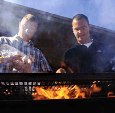
USDA Offers Food Safety Grilling Tips
With the days getting longer, the weather getting warmer, and Memorial Day finally here--all signs that the summer grilling season soon to be upon us--USDA is reminding the public that safe food handling skills are the key to making a cookout a big hit with guests.
"When you're enjoying a cookout with friends and family, the last thing you want to do is make them sick," said Dr. Richard Raymond, under secretary for food safety. "Before you even fire up the grill, you need to be aware of safe grilling and food preparation practices that will make sure your guests enjoy a tasty and safe meal."
Whether you're hosting a neighborhood barbecue or cooking for a few friends and family members, USDA's Meat and Poultry Hotline offers four easy steps to help you be food safe and reduce the threat of foodborne illness:
Clean: First things first--make sure to start with clean surfaces and clean hands. Be sure that the host and guests wash their hands before preparing or handling food. Hands should be washed with soap and warm water for 20 seconds before and after handling food. Equally important are the surfaces that come in contact with raw and cooked foods--make sure they are clean and are washed frequently.
Separate: Raw meats and poultry should be prepared separately from veggies and cooked foods. When chopping meats and veggies, be sure to use separate cutting boards. Juices from raw meats can contain harmful bacteria that could cross-contaminate raw veggies and already cooked foods.
Cook: Masters of the grill are no match for foodborne illness, so it's important to have all the right tools. A food thermometer is the most important tool that will tell a cook if the food is thoroughly cooked, as color is not a reliable indicator of doneness.
Meat and poultry cooked on a grill often brown quickly and may appear done on the outside, but still may not have reached a safe minimum internal temperature to kill any harmful bacteria. Steaks, roasts, and chops should be cooked to 145 degrees F. Hamburgers should reach 160 degrees F. All poultry should reach a minimum of 165 degrees F. Fish should be cooked to 145 degrees F. Fully cooked meats like hot dogs should be grilled to 165 degrees F or until steaming hot.
When taking the cooked meats off the grill, be sure to place them on a clean plate or platter, NOT on the unwashed dish that held them when they were raw. The juices left on the plate from the raw meats can cross-contaminate cooked foods.
If meats are prepared using a smoker, the temperature in the smoker should be maintained between 225 and 300 degrees F for safety. Be sure to use a food thermometer to be certain the food has reached a safe minimum internal temperature.
Chill: Keeping food at a safe temperature is always a major concern at picnics and cookouts. Too often, food is prepared and left to sit out while guests munch over the course of several hours. However, bacteria can start to grow on perishable food that has been sitting out too long.
It's important to keep hot food hot and cold food cold, USDA said. Hot food can be kept safe at 140 degrees F or above in chafing dishes, slow cookers, or warming trays, and cold food can be kept chilled at 40 degrees F or below with ice packs or ice sources underneath.
Perishable food should never sit out for more than two hours. And if the temperature is above 90 degrees F--which can be common at summer picnics--perishable foods shouldn't sit out more than one hour. Refrigerate or freeze leftovers promptly and discard any food that has sat out too long.
A good resource available before planning a summer cookout is USDA's virtual representative, "Ask Karen," a feature that allows users to ask food safety-related questions 24 hours a day. Visit "Ask Karen" at AskKaren.gov. Food safety coaches are available by phone at the USDA's Meat and Poultry Hotline at 1-888-MPHotline (1-888-674-6854).